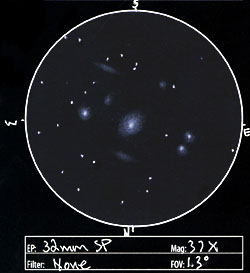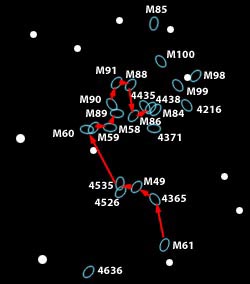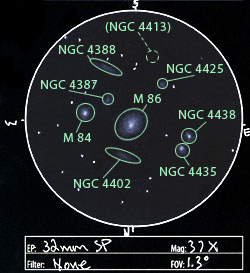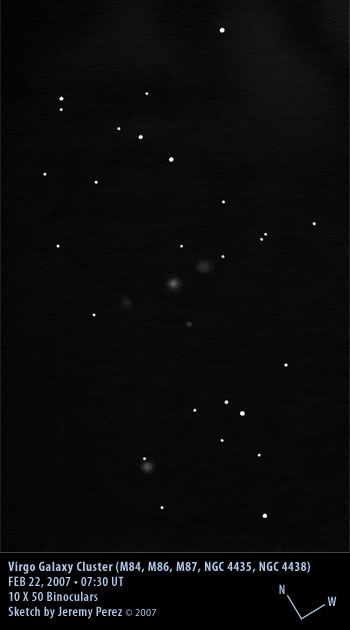Binocular Observation: February 22, 2007
Move mouse over sketch to see labels. Click image for larger version.
The broad stretches of the Virgo Cluster of Galaxies are a real treat telescopically, but what does it look like through binoculars? And not just any old astronomy-grade binoculars, but really crummy ones? Well, I and my twenty dollar laughing-stock 10x50 binoculars are happy to say that you can indeed enjoy these galactic poofs on a bino-budget. But you'll still need a dark sky on your side.
Drawing a bead--and a crick'd neck--on the heart of the cluster slowly revealed two soft patches that are the bright galaxies, M84 and M86. M86 was the brighter of the two, and appeared more strongly concentrated at its core. It was also hard to miss the soft glow of M87 as it hugged a nearby eighth magnitude star. With some patience, a much more elusive smear appeared east of M86 from the combined light of NGC 4435 and 4438. I also noted a soft glow due south of M86 that turned out to be the unresolved glow of a grouping of stars in the area.
So, what can I say? If your current choice of binoculars gives you just a wee touch of shame, but you've got a dark sky to play with, go ahead and grab those dogs, and a pack of ice for your neck, and give some Virgo galaxies a shot. You may be pleasantly surprised.
| Subject | M84 (NGC 4374); M86 (NGC 4406); M87 (NGC 4486); NGC 4435; NGC 4438 |
| Classification | M84: Lenticular Galaxy - Type S0 M86: Lenticular Galaxy - Type S0 M87: Elliptical Galaxy - Type E1 NGC 4435: Spiral Galaxy - Type SB0 NGC 4438: Spiral Galaxy |
| Position* | M84: Virgo [RA: 12:25.1 / Dec: +12:53] M86: Virgo [RA: 12:26.2 / Dec: +12:57] M87: Virgo [RA: 12:30.8 / Dec: +12:24] NGC 4435: Virgo [RA: 12:27.7 / Dec: +13:05] NGC 4438: Virgo [RA: 12:27.8 / Dec: +13:01] |
| Size* | M84: 5'; M86: 7.5' x 5.5'; M87: 7.0'; NGC 4435: 3' x 1.9'; NGC 4438: 9.3' x 3.9' |
| Brightness* | M84: 9.1; M86: 8.9; M87: 8.6; NGC 4435: 10.8; NGC 4438: 10.0 |
| Date/Time | February 22, 2007 - 12:30 AM (February 22, 2007 - 07:30 UT) |
| Observing Loc. | Cinder Hills Overlook, Sunset Crater National Monument, AZ |
| Instrument | 10 x 50 Binoculars |
| Conditions | Clear, calm |
| Seeing | 3-4/10 Pickering |
| Transparency (NELM) | Mag 6.8+ |
| Sources | SEDS, The NGC/IC Project |
*Based on published data.
Sketch Update: January 11, 2007

After a recent discussion at CloudyNights.com about getting the most believable results from galaxy sketches, I took another look at some of my older sketches. This sketch of the heart of the Virgo Cluster really begged for some help. Eventually, I'm going to redo the sketch at the eyepiece, but for now, I've digitally cleaned up the stars, the background, and mostly smoothed out the lumpy galaxies. Those lumps were the result of a hurried sketch on paper that I no longer care to use for blending extended objects such as these. I also got rid of that annoying blue tint I used to give to my sketches. Funny how tastes change, ain't it?
Original Entry: May 7, 2005

Last Saturday, a friend of mine, Michael Poppre, drove up from Phoenix to do some high altitude star watching. He brought his 150 mm newtonian, and we drove up to Anderson Mesa for some observing. For the most part, we spent our time cruising through the galaxies in Virgo, Leo and Coma Berenices. As I've worked through the Astronomical League's Messier observing program, I've known that the Virgo Galaxy Cluster would be coming up on the roster for late Spring. I really should find some comfort that Messier only catalogued sixteen of the 2000 or so galaxies in the cluster. My six inch scope isn't a big galaxy grabber by any means, but the sky at Anderson Mesa can be fantastically dark. I decided I'd do a dry run through the cluster and see how far I got before getting lost.
I checked my Bright Star Atlas and decided to start the tour at M61, a lone galaxy, easy to find near a bright star in Virgo (16 Vir). Once I had it centered, I started galaxy-hopping degree by degree, field-of-view by field-of-view along a curling stream of galactic seed-pods. I found it very satisfying to see the galaxy-hopping process work so well. Because we had a reasonably dark sky, a number of other unplotted galaxies showed up along the way, but inevitably, the brightest ones were right where the atlas said they should be.

At the end of my tour was an area that turned out to be a big train wreck of galaxies which I found is called the "Heart" of the Virgo Cluster. At first glance I saw 4 galaxies, then 5, and even at that point I felt excited to see so many gathered in one spot. As I stared more intently however, more galaxies began to show, until I finally counted 8. I felt a little bad getting so absorbed in the observation while Mike was there observing with me, but I had to sketch the view.
Two of the galaxies are bright Messier objects (M84 and M86). Another 2 are listed in the Bright Star Atlas (NGC 4435 & 4438). The identities of the other 4 I had to dig up later at home. And this is just through my 6" scope. I was very pleased to get such a view. I imagine the field must be crazy through larger scopes. As it is, I was in a bit too much of a hurry and missed sketching NGC 4413, which would have brought the total in the eyepiece to nine.

M84 was bright and spherical with a stellar core. M86 was larger, slightly elongated northwest to southeast, and also had a stellar core. NGC 4435 and NGC 4438 marked the east side, and at first glance looked like bright stars. Further inspection showed them to be circular, soft-edged galaxies with nice stellar cores as well. They appeared to be about 8' from core to core. NGC 4402 and NGC 4388 were strongly elongated members of the group and appeared to point roughly west-southwest to east-northeast. NGC 4387 and NGC 4425 were dimmer and sherical, brighter towards the center, but not noticeably stellar. The entire view was beautiful.
Object Information
The Virgo Cluster of Galaxies is the closest big galaxy cluster with about 2000 members. Our Local Group of Galaxies, including our home galaxy, the Milky Way, is gravitationally bound to this cluster. Although our Local Group is currently moving away from the center of the Virgo Cluster, it is gradually accelerating back toward this gravitational monster. Because of the strong gravitational influence, some of the member galaxies have been accelerated to considerably high velocities. In fact some of these galaxies exhibit the greatest blue-shifts of any galaxies so far measured--such as IC 3258 which is approaching us at 517 km/sec. Since the center of mass of the cluster is moving away from us at 1100 km/sec, this galaxy must be moving at over 1600 km/sec through the cluster.
Charles Messier discovered this association of galaxies, which he called a "cluster of nebulae" in 1781. He eventually catalogued 16 of the galaxies (M49, M58, M59, M60, M61, M84, M85, M86, M87, M88, M89, M90, M91, M98, M99, and M100). His associate, M. Méchain noted even more "Nebulae" that Messier had not observed.
M84 has long been classified as an E1 elliptical galaxy. However, there is recent evidence that it may be a face-on lenticular galaxy. It is populated by old yellowish stars and has a significant collection of globular clusters. It also is ejecting two small jets that are visible in the radio spectrum. The core of M84 contains a massive object of 300 million solar masses.
M86 is either an E3 elliptical or an S0 lenticular galaxy. It has a very noticeable system of globular clusters and a faint dwarf elliptical companion. While IC 3258 is approaching us at an incredible speed of 517 k/sec, M86 is the fastest approaching Messier Galaxy at 419 km/sec.
| Subject | M84 (NGC 4374) M86 (NGC 4406) NGC 4387 NGC 4388 NGC 4402 NGC 4425 NGC 4435 NGC 4438 |
| Classification | M84: Lenticular Galaxy - Type S0 M86: Lenticular Galaxy - Type S0 NGC 4387: Elliptical Galaxy NGC 4388: Spiral Galaxy - Type SA(s)b:sp II NGC 4402: Spiral Galaxy - Type Sbsp NGC4425: Transitional Galaxy - Type S0-a III NGC 4435: Spiral Galaxy - Type SB0 NGC 4438: Spiral Galaxy |
| Position* | M84: Virgo [RA: 12:25.1 / Dec: +12:53] M86: Virgo [RA: 12:26.2 / Dec: +12:57] NGC 4387: Virgo [RA: 12:25.7 / Dec: +12:49] NGC 4388: Virgo [RA: 12:25.8 / Dec: +12:40] NGC 4402: Virgo [RA: 12:26.1 / Dec: +13:07] NGC 4425: Virgo [RA: 12:27.2 / Dec: +12:44] NGC 4435: Virgo [RA: 12:27.7 / Dec: +13:05] NGC 4438: Virgo [RA: 12:27.8 / Dec: +13:01] |
| Size* | M84: 5'; M86: 7.5' x 5.5'; NGC 4387: 1.8' x 1.1'; NGC 4388: 5.6' x 1.3'; NGC 4402: 3.9' x 1.1'; NGC 4425: 3.4' x 1.2'; NGC 4435: 3' x 1.9'; NGC 4438: 9.3' x 3.9' |
| Brightness* | M84: 9.1; M86: 8.9; NGC 4387: 12.1; NGC 4388: 11.0; NGC 4402: 11.3; NGC 4425: 11.8; NGC 4435: 10.8; NGC 4438: 10.0 |
| Date/Time | May 7, 2005 - 10:30 PM (May 8, 2005 - 05:30 UT) |
| Observing Loc. | Flagstaff, AZ - Anderson Mesa |
| Instrument | Orion SVP 6LT Reflector (150 mm dia./1200 mm F/L) |
| Eyepieces/Mag. | 32 mm (37X) |
| Conditions | Clear, 33°F |
| Seeing | 3-4/10 Pickering |
| Transparency (NELM) | Mag 6.4 |
| Sources | SEDS, The NGC/IC Project |
*Based on published data.






Hello, thanks a lot for the huge tip! I tried and I could see the heart of the Virgo Galaxy with my binoculars, it is the most exciting astronomical sight I have ever had, to peer to 60 million years in distance and into the past, and the place where we are being pulled to, it's mind boggling. Best Regards, Carlos
Carlos, my pleasure. Thanks for sharing your experience! To be able to view something so distant and immense with a simple pair of binoculars is pretty amazing.
Jeremy
Hello Jeremy,
Yes it's inspiring, cosmological, I have just repeated the observation and I can clearly distinguish the Galaxies as you listed them:
NGC 4435 & NGC 4438 (my favorites! because they are interacting)
M86
NGC 4387
M84 , NGC 4388
I would have never imagined it possible with a pair of binoculars and in the outskirts of the light polluted Mexico City, well of course these have been nights without a Moon.
Best Regards,
Carlos
Carlos, great catch on NGC 4387 and 4388! I'll have to examine this group more closely at some point & see how much deeper I can go with binoculars.
Jeremy